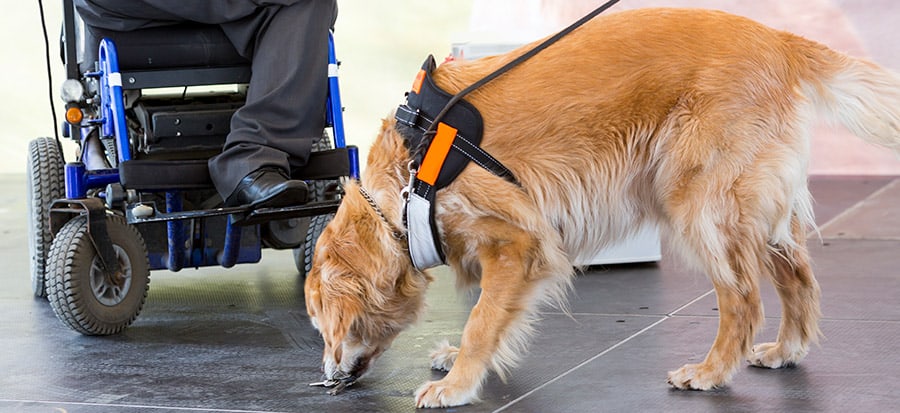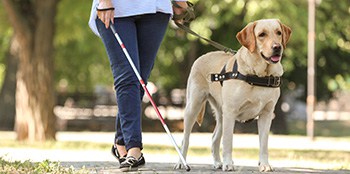
Service dogs have been around for more than 30 years and continue to play an important role in helping disabled individuals function in their daily lives. The first service dog was trained by Bonita Bergin, an American canine researcher who started the Bergin University, a canine school that teaches service dogs more than 100 different commands.
The Americans with Disabilities Act, a division of the Department of Justice, recognizes service dogs
Types Of Service Dogs
- Service Dogs for Seizures – sense and alert the handler when a seizure is approaching
- Service Dogs for Autism – assist with fine and gross motor skills, behavioral skills, socialization skills, and various life skills
- Service Dogs for Anxiety and Depression – help calm their owner during times of anxiousness and stress
- Service Dogs for Diabetics – alert their owner when their blood sugar levels reach dangerous levels
- Service Dogs for the Blind – guide their owners through life by acting as their ‘eyes’
- Service Dogs for Veterans and PTSD – recognize signs that their owner is about to have a panic attack and help them calm down
- Service Dogs for Mobility Impairment – trained to perform physical and meticulous tasks to assist those confined to wheelchairs
- Service Dogs for Hearing Impairment – alert their owners to common sounds and bring them to the source
How Service Dogs Are Used
A service dog goes through a rigorous training program to learn a specific set of skills, skills that make them compatible to work with certain medical conditions.
Service Dogs for Seizures – Seizure Alert Dogs
Seizure dogs are able to detect when their owner/handler is about to have a seizure and can assist them in different ways. Prior to or during the seizure, the dog may perform the following duties.
Typical Duties
- Staying close to the owner during the seizure to prevent injury
- Alerting a family member, caretaker or emergency response team
- Displaying certain alert warning before the seizure starts
- Grabbing medication, a telephone or an alert device
- Turning on a light or opening a door
Training
Seizure alert dogs are trained to act in a certain manner when their owner is about to have a seizure. The type of warning they give their owner depends on the type of training they received. Prior to having the seizure, the owner may notice the dog acting in a certain manner, which is the dog’s way to alert the person that he or she is about to have a seizure.
- Pacing or circling
- Making close eye contact
- Licking
- Pawing
- Moving around restlessly
It was discovered that humans give off a certain scent during a seizure and some dogs are able to detect this scent. Once trainers determine which dogs are able to detect this, they are trained to respond using click or positive reinforcement training. The dogs spend at least two years in training. They’re housebroken and receive basic obedience training as well as a year of advanced training from professional trainers.
The dog is also evaluated to ensure the dog is temperamentally and emotionally stable and physically sound. After the seizure alert training is finished, the dog has personalized training with the individual the dog will be living with to develop and bond and sense of familiarity.
Service Dogs for Autism – Autism Assistance Dogs
Service dogs for autistic children are trained to perform a variety of tasks to help with the many issues facing a child with autism. These may include fine and gross motor skills, behavioral skills, socialization skills, and life skills. Despite autism service dogs being highly trained, tolerant, gentle and intelligent, each dog has its own personality as does each child.
One child may benefit from a quiet reserved dog while another may benefit more from a playful dog that enjoys attention. The dog is matched with an appropriate child, which is based on an interview and evaluation process. The dog may perform in a variety of ways.
Typical Duties
- Put its head on the child’s lap to calm a child or eliminate undesirable behavior
- Flip on a light switch if the child is afraid of the dark.
- Put its paws on the child’s legs to help with sensory integration
- Bark if the child needs assistance
Because autism service dogs are generally trained to bark only on command, parents or caretakers know that if the dog barks, something is wrong. Autistic children sometimes suffer from anxiety while shopping, at medical or dental appointments, during school activities or when around loud noise. Occasionally, the dog accompanying the child is enough to calm down the child and decrease the anxiety. When faced with these situations, the dog may lean against the child or lay his or her head on the child’s lap. In many cases, the dog does not just do something to the child but also alerts the parents or caretakers.
Training
As is the case with many service dogs, it can cost more than $20,000 to train a service dog for autism. It takes about two years to socialize and train the dog before it can be matched with a child. The dog is also trained to cope with different public places and environments. The dog will often be fitted with a harness that is also attached to the child to prevent the child from wandering off too far.
Service Dogs for Anxiety and Depression – Psychiatric Service Dog
People suffering from anxiety and depression often find it difficult to function normally throughout their day, and having a service dog can help them immensely. Service dogs helping people with anxiety and depression are often called psychiatric service dogs. Here are some of the ways they help a person suffering from anxiety.
Typical Duties
- Bring medication to the person during an anxiety attack or at a certain time of day
- Bring the telephone to the person if they are suffering an anxiety attack
- Leading another person to their owner when he or she is anxious
- Licking the person’s face to calm them if they’re having an emotional meltdown
- Putting pressure on the person’s chest or stomach if they’re in distress
The dog may also be able to detect an anxiety attack before it actually happens and takes measures to calm the person to prevent the attack. In addition to the actions they provide for anxiety, the service dog can also help with depression. Just caring for the dog alone often gives the person a sense of purpose and something to do to take their mind off of their depression. Being around the dog can help decrease depression in several ways.
- Exercise – Taking the dog for regular walks provides the individual with exercise.
- Feeding the dog – This gives the person a sense of worth by having to take care of the animal.
- Spending time outside – The more exercise and playtime the individual gives the dog, the more fresh air and sunshine he or she is getting, which helps with physical and mental health.
- Company – Dogs provide friendship and love.
- Stress relief – It has been proven that spending time with dogs is a great stress reliever.
Training
Training a service dog for anxiety or depression involves teaching the dog to perform in a certain way when the dog hears a certain noise. For instance, the trainer may give the dog a treat each time the dog nudges his leg. When the dog becomes familiar with that action, the trainer will make an anxious sound just before the dog begins nudging. After much repetitive training, the dog learns to perform certain actions when it hears the person make specific anxiety signs.
Service Dogs for Diabetics – Diabetic Alert Dogs
Diabetic service dogs are trained to alert their diabetic owners before the person’s blood sugar levels become too dangerously high or low so that the person can take steps to fix the problem. When the human body is experiencing high or low blood sugar levels, it releases chemicals that have a very distinct odor that, while it may be undetectable to us, it is detectable to dogs.
Main Duty
- Alert their owner/handler when their blood sugar level becomes dangerous
Training
A lot of training goes into diabetic service dogs. The basic training begins at birth and continues for about 18 months, at which time, the dog will begin specialized training. The training involves introducing and familiarizing the dog with the blood sugar odor and motivating the dog to give alerts to the owner when the dog detects the odor. The person in need of the diabetic service dog is given a scent collection kit to provide trainers with their blood glucose samples.
The trainers use these samples to provide the dog with specialized training for the diabetic person the dog will be living with. The dog is trained to provide the diabetic with a specific alert when the dog detects the odor. Diabetic service dogs that are categorized as medical-alert service dogs have special rights that are protected under the Fair Housing Act, the Americans with Disabilities Act and the Air Carrier Access Act.
Service Dogs for the Blind – Visual Assistance Dogs
Service dogs for the blind, also known as seeing-eye dogs, have been around for many years. An individual in need of a seeing-eye dog is required to complete an application, complete a telephone interview, complete a home visit and participate in an in-person training program with at the service dog school. The program will fit the right dog with the person, and the two of them will complete an extensive training program.
The dog’s training can take six months or longer. Before an individual can be fitted with a service dog for the blind, most organizations require that the individual be able to:
- Master orientation and mobility skills
- Cross the street
- Travel independently with a cane
- Walk safely in familiar areas
- Problem solve if they become lost
- Find destinations
The visually impaired person must know how to get to a specific destination. The dog is trained to get the person to the destination safely, but the individual must have a familiarity with the surroundings. The dog will ensure that there are no obstacles or dangers in the way. The National Federation of the Blind offers a list of resources for those looking for service dogs for the blind or visually impaired.
Service Dogs for Veterans and PTSD
Service dogs have been highly effective for people who have Post-Traumatic Stress Disorder (PTSD), particularly veterans. Service dogs have been so beneficial and useful in helping combat these issues that the government has been providing funding to organizations who specialize in training service dogs. In many cases, many of the dogs come from rescue organizations.
The dogs are carefully screened, and those that are deemed appropriate go through an extensive training program. These dogs are not only trained to recognize the signs that their owner is about to have a panic attack but also to help the veteran calm down and help them recover. A person suffering from PTSD may have a severe anxiety attack when triggered by certain things like loud or strange noises.
Typical Duties
- Turning lights on for the person
- Retrieving medication
- Performing safety checks of rooms before entering the home
- Waking up the person if he or she is having a night terror
- Preventing strangers from approaching if the person is in distress
- Distracting the person having an anxiety attack by licking or pawing them
- Providing deep pressure therapy against the owner to soothe the individual
- Grounding the person when having a flashback
- Guiding the owner home after he or she has had a PTSD attack
When a veteran or someone with PTSD requires a service dog, it’s crucial that they request a psychiatric service dog. Many mistakenly believe that they need a therapy dog. The problem with this is that therapy dogs are not categorized as service dogs under the Americans with Disabilities Act and won’t be given the same privileges as true service dogs. In addition to the many tasks they can provide, these service dogs can also:
- Help lower blood pressure
- Help maintain serotonin levels
- Help with depression
- Prevent the individual from being crowded
- Provide great companionship
Training
Service dogs for veterans and PTSD receive not just basic obedience but also detection and response training. Once the dog learns basic obedience and develops a bond with the handler, the dog is given specific cues for if and when the handler acts in a certain way.
If, for instance, the handler is afraid of heavy traffic, the handler may give the dog a treat at the onset of heavy traffic, so the dog learns to act in a specific manner just before heavy traffic. This works with various types of stress or anxiety-related situations. After a while, the dog will detect these situations before they happen and respond appropriately.
Service Dogs for Mobility Impairment – Brace/Mobility Support Dogs
Service dogs for mobility impairment are probably the dog that most comes to mind when we hear the word service dog. These specially-trained dogs work with people in wheelchairs and those who have difficulties with mobility. Mobility assistant service dogs perform tasks that disabled individuals would not be able to do on their own, allowing them to live independent lives.
Typical Duties
- Retrieving dropped items
- Grabbing objects that are out-of-reach and bringing them to the owner
- Pushing buttons on automatic doors
- Assist with pulling a wheelchair up a ramp
- Act as a brace for a person with poor balance
- Open and close doors
- Opening and shutting drawers and cabinets
- Turn lights off and on
- Find another person in the home if help is needed
Training
Because a lot of the tasks the dog is required to do are physical and require meticulous and detailed precision, the dog must go through a rigorous training program. They must be able to perform the required tasks not just at home but often out in public and possibly in unfamiliar surroundings. In the case where the individual might fall and become injured or get sick, the dog must be able to assist the person. The dog might have to drag the person to a safe location, turn the body over, bring medical supplies to the individual or run to get another person for help.
In general, mobility assistance dogs can assist in all areas of the individual’s life, including helping them on public transportation like buses and airplanes. The law states that an individual requesting a mobility assistance service dog must have a physical, psychiatric or developmental disability.
Service Dogs for Hearing Impairment
Service dogs for hearing impaired people are specially trained to help people who are deaf for hard of hearing.
Typical Duties
- Alert their owners to common sounds, such as:
- Ringing telephone
- Alarm clock
- Doorbell
- Smoke Alarm
- A child crying
- Guide their owner to the sound
Training
The dog is trained to alert their owner when they hear these sounds by pawing or nudging the owner. Once they’ve alerted the owner, they lead the person to the location of the sound. Hearing impaired service dogs may also be trained to respond to sign language for owners who can’t speak. The dogs must receive specific training with the agency as well as in the individual’s home so the dog knows what sounds he or she should be alerting the owner to and which ones are common sounds.
For instance, the dog will typically be trained to ignore the sound of traffic driving by or horns blowing but will alert the owner of traffic coming in their driveway. The dog may also be trained to behave in certain ways to designate a specific sound. For instance, the dog may run to the door if the doorbell is ringing but go by the phone if the phone is ringing.
Related Questions
Can a child with autism bring their service dog to school?
Yes, the ADA states that a student with a disability may have his service animal with him at school. Even if the dog does not satisfy the ADA’s definition of a service dog, the student can still bring the dog with him to school if it is determined by the Section 504 of the Rehabilitation Act and Individuals with Disabilities Education Act that the dog is necessary for the student to receive an appropriate education.
Does a service dog have to be a particular breed?
Although some dog breeds make better candidates for service animals, no requirements state that a service dog can only be a certain breed. The only requirements the dog must meet are that the dog must be able to provide the specific tasks required by the disabled person.
Where can a disabled person get a service dog?
Numerous organizations across the United States offer service dogs for various disabilities, including those who have blindness, hearing problems, mental illnesses, and diabetes, among others. The Dog People is just one of many online sites that offer information on finding an appropriate service dog.
A Real Lifesaver!
Few people understand the vital role that service dogs play in helping a disabled person lead as normal a life as possible. They’re more than a pet or a companion, although, they can be that, too. Their extensive training allows them to provide the individual with 24/7 care and attention. In many cases, service dogs prove to be real lifesavers!




